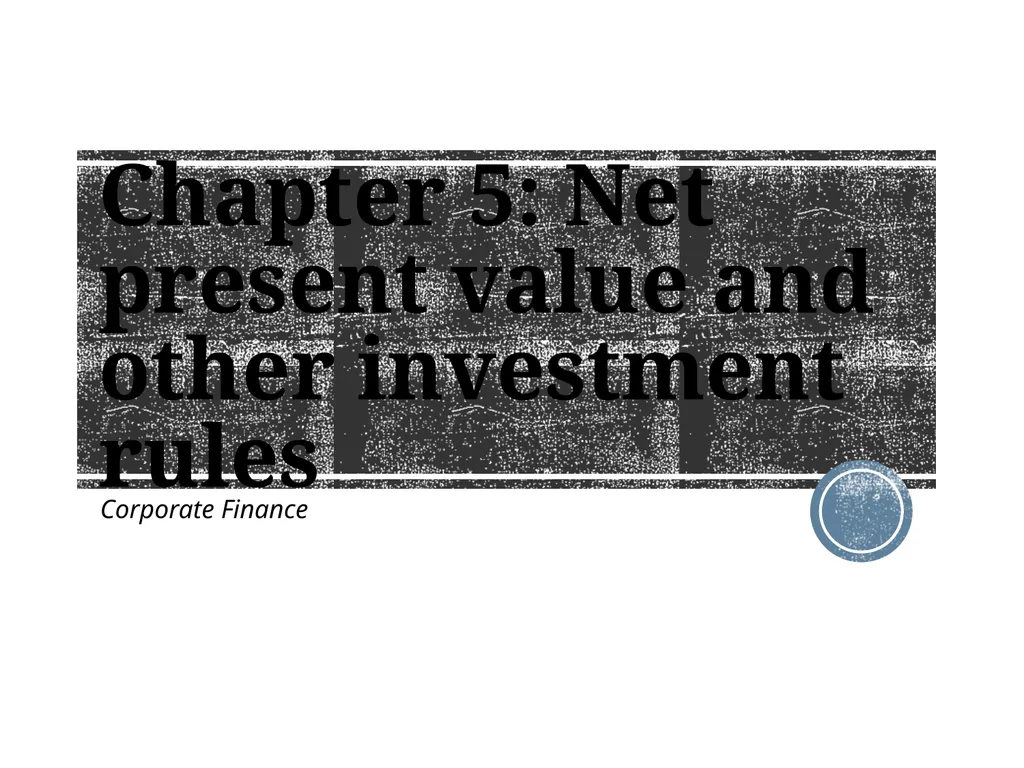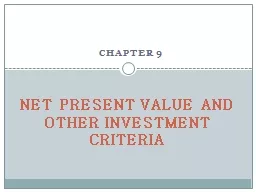Chapter 5: Net present value and other investment
Author : giovanna-bartolotta | Published Date : 2025-06-23
Description: Chapter 5 Net present value and other investment rules Corporate Finance Outline 1 Net present value NPV 2 The payback period method 3 The discounted payback period method 4 The Internal rate of return IRR 5 The profitability
Presentation Embed Code
Download Presentation
Download
Presentation The PPT/PDF document
"Chapter 5: Net present value and other investment" is the property of its rightful owner.
Permission is granted to download and print the materials on this website for personal, non-commercial use only,
and to display it on your personal computer provided you do not modify the materials and that you retain all
copyright notices contained in the materials. By downloading content from our website, you accept the terms of
this agreement.
Transcript:Chapter 5: Net present value and other investment:
Chapter 5: Net present value and other investment rules Corporate Finance Outline 1. Net present value (NPV) 2. The payback period method 3. The discounted payback period method 4. The Internal rate of return (IRR) 5. The profitability index Good decision criteria Does the rule take the time value of money into consideration? Does the rule adjust for risk? Does the rule tell us whether and by how much the project add value to the firm? A proposed project Your company is looking at a new project that has the following cash flows. Year 0: initial cost, C0 = $100,000. Year 1: CF1 = $30,000. Year 2: CF2 = $50,000. Year 3: CF3 = $60,000. The applicable discount rate is 10%. 1st method: the NPV rule NPV = PV – C0: the difference between the present value of the investment’s future net cash flows, i.e., benefits, and its initial cost. Ideas: (1) an investment is worth undertaking if it creates value for its owners, and (2) an investment creates value if it worth more than it costs within the time value of money framework (Chapter 4). Decision rule If NPV > = 0, accept the project. If NPV < 0, reject the project. A positive NPV suggests that the project is expected to add value to the firm, and the project should improve shareholders’ wealth. Because the goal of financial management is to increase shareholders’ wealth, NPV is a good measure of how well this project will meet this goal. Project NPV Judging the NPV rule Does the NPV rule take the time value of money into consideration? Does the NPV rule adjust for risk? Does the NPV rule tell us whether and by how much the project add value to the firm? Finally, they listen CFOs are using what academics consider better measures in their capital-budgeting analysis. According to a recent survey, more than 85 percent say they use net present value (NPV) analysis in at least three out of four decisions…."Finance textbooks have taught for years that NPV is superior, but this is the first known survey to show it's the preferred tool," says co-author Patricia A. Ryan, a professor of corporate finance at Colorado State University. Source: CFO.com. 2nd method: payback period Payback period: the amount of time required for an investment to generate after-tax cash flows sufficient to recover its initial cost. Decision rule An investment














